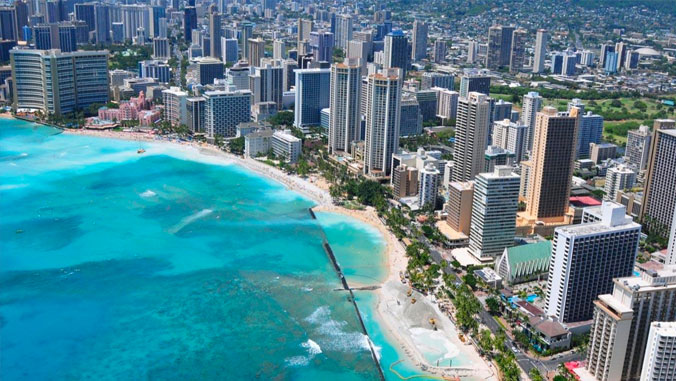
If Waikīkī Beach completely eroded, the state could lose more than $2 billion in visitor spending and related economic revenues each year, according to an economic impact analysis report by the Sea Grant College Program and Department of Economics at the University of Hawaiʻi at Mānoa.
Waikīkī Beach, formerly the residence and playground of Hawaiʻi’s king and high chiefs, became the “playground of the Pacific” in the early- to mid-1900s, and remains the most iconic landmark in the state today, drawing millions of visitors to the islands each year.
Now the main stretch of Waikīkī Beach is in danger of completely eroding, and the report found that if the concrete wall (groin) that was built in 1927 in front of the Royal Hawaiian fails, visitors wiil stop flocking to Waikīkī. The state Legislature recently allocated $13 million to reconstruct the Royal Hawaiian groin and a new temporary sandbag groin at Kuhio Beach fronting the Duke Kahanamoku statue. The appropriation will also be used for beach improvement projects outlined in the draft Waikīkī Beach Master Plan.

The Hawaiʻi Department of Land and Natural Resources (DLNR) in partnership with Hawaiʻi Sea Grant and the Waikīkī Beach Special Improvement District Association (WBSIDA) are developing the master plan. The plan relies heavily on input from the Waikīkī Beach Community Advisory Committee.
An effective partnership
“Hawaiʻi Sea Grant has been serving in a technical and scientific advisory role to the Waikīkī Beach Special Improvement District since it was created in 2015,” said Dolan Eversole, Waikīkī Beach management coordinator and a coastal processes specialist with Hawaiʻi Sea Grant. “It has also been collaborating with DLNR and WBSIDA in the development of the beach improvement projects in Waikīkī and assisting with community outreach. This advisory role has proven to be a very effective partnership with local, state and nonprofits, and has demonstrated success in helping to inform the decision-making process for such high-profile improvement projects in Waikīkī.”
While the master plan has an expected completion date of 2021, three project priority areas (Halekulani, Royal Hawaiian and Kuhio Beach cells) emerged, with projects ranging from beach restoration using offshore sand pumped to shore, adding or restoring existing beach stabilizing structures and relocating sand back to its initial point of origin.
—By Cindy Knapman


